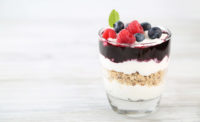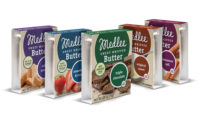2019 State of the Industry report: Milk aims for an inside straight
Despite milk’s streak of bad luck, innovative products with functional benefits are holding the high cards.












At first glance, it seems that milk hasn’t been dealt the best hand. But the beverage isn’t considering folding: While purchasing numbers have declined in recent years, it’s still present in 91% of American households, according to the September 2019 “Eating Trends: Meat, Dairy, Vegetarian, and Vegan” report from the Packaged Facts division of Rockville, Md.-based MarketResearch.com.
But milk should bet cautiously. Overall, dollar and unit sales are down 1.3% and 2.3%, respectively, during the 52-week period ending Aug. 11, 2019, according to data from Chicago-based market research firm IRI.
Milk | Cheese | Cultured | Ice Cream | Butter | Non-dairy Beverages | Ingredients | Exports
Refrigerated skim/low-fat milk — in particular — is hoping for a better hand next year. Dollar sales fell 5.2%, and unit sales declined 5.6%. Whole milk, however, is holding more chips. It’s dollar and unit sales are up 1.8% and 0.9%, respectively.
“In my two decades of work with the dairy industry, I can’t think of a time when the milk category has been more challenged,” said Julia Kadison, former CEO of the Washington D.C.-based Milk Processor Education Program (MilkPEP). “Yet, milk is an amazing product that truly does align to today’s consumer needs — it’s wholesome, fresh, local, delicious [and] produced by farmers who care about the earth and their animals.”
Milk’s nosebleed stakes
The elephant in the dairy case are plant-based beverages, which continue to shave away at milk’s market share. According to data from the San Francisco-based Plant Based Foods Association, dairy alternatives grew 6% in the past year.
However, many plant-based beverage consumers aren’t throwing milk aside completely: They’re part of the growing “flexitarian” trend of consumers who consume both dairy and nondairy beverages. Milk retains a much higher percentage of market penetration, but is losing the marketing battle, said Erin Massey, product development manager for Prairie Farms Dairy Inc., Edwardsville, Ill.
“Nondairy plant-based beverages … are leading the marketing narrative with consumers even though they make up a small portion of overall sales,” she said.
According to Rebecca Heagney, director of marketing for Kemps, part of Dairy Farmers of America, Kansas City, Kan., today’s consumers have a plethora of beverage options, and this has impacted milk sales.
“While milk is still purchased by more than 90% of households, there are so many beverage choices available to consumers today,” she said. “So it’s critical that we figure out how to remain relevant to an ever-changing consumer mindset.”
Milk processors could benefit from understanding that dairy and nondairy alternatives often are used for different occasions, said Rick Beaman, vice president of Hiland Dairy Foods Co., Springfield, Mo.
“We know that 50% of households that consume both milk and milk alternatives do so because each has its place for different uses,” he said.
Innovative marketing approaches may bring more people back to the milk case. For its part, MilkPEP started a “new consumer communications platform” that aims to connect with consumers emotionally by tying special life moments to milk, Kadison said.
“And, in partnership with DMI [Dairy Management Inc.], we’re tackling some of the business issues that are holding back milk growth, including fighting to win against competitors in the milk case and investing in data and insights that can be shared to ensure milk brands have leading-edge, competitive and powerful strategies, and plans to drive the category forward,” she continued.
According to Meenakshi Trehan, vice president of brand and innovation, Organic Valley, La Farge, Wis., winning over children is essential to the long-term success of milk. The company’s approach includes increasing parent-oriented communication to appeal to the whole household.
“Kids are a must-win category battleground. The more we can deepen category appeal, engagement and connections for consumers in this relationship-forming entry-stage category, the more likely we will retain those entry-stage consumers over the long term,” she added.
Functional beverages bet big
With so many of today’s consumers looking for healthy foods and beverages, milk processors should leverage milk’s nutritional profile, said Heagney.
“With all the beverage choices today, milk still offers a powerful nutrient package, so we think there’s value in continuing to talk about its inherent benefits, which very few beverages can compete with,” she said. “Added value benefits are a big space for product development opportunities — consumers across the board are looking to their food and beverages to do more. So benefits like probiotics, added protein, calcium and new, exciting taste experiences will be important opportunities.”
Trehan said that emphasizing the protein content in milk could help win over some consumers.
“Since [the] skim and 1% milk segments are seeing a decline in consumption, we spent time with these consumers to better understand their needs,” she said. “What we found was 27% of dairy buyers and 35% of nondairy buyers say extra protein will encourage them to drink more milk.”
To meet this demand, Organic Valley introduced a couple of high-protein milk products this year. Its new Ultra line of ultrafiltered organic milk has 50% more protein and 50% less sugar than regular milk, the company said.
Organic Valley also relaunched its Fuel protein shakes. The offerings now have 50% less sugar than before; they are packed with 20 grams of organic protein and come in Chocolate, Vanilla and Coffee flavors.
“New and improved organic Fuel was developed in response to consumer demand for high-protein, low-sugar options produced without toxic pesticides or artificial growth hormones,” said Trehan. “A healthy on-the-go snack, post-workout recovery shake or an afternoon energy boost, Fuel is the perfect nutritious beverage for busy lifestyles.”
Horizon Organic, part of Danone North America, based in White Plains, N.Y., and Broomfield, Colo., joined the trend by introducing Horizon Organic High Protein in Reduced Fat Chocolate, Reduced Fat Plain and Vitamin D varieties. It includes 12 grams of organic protein per serving, said Domenic Borrelli, president of premium dairy for Danone North America.
“Our High Protein milk is a perfect example of how Horizon has kept up on trends and innovated in the space, contributing to growth in the category, especially against consumer wants and needs,” he added. “We’re now seeing high-protein milks being used in households as a complement to regular milk as opposed to being reserved for more niche consumption moments.”
Meanwhile, Seattle-based Darigold said it created its new Darigold Fit line to respond to consumer demand for less sugar and more protein in dairy products. The milk, which is ultafiltered and lactose-free, contains 75% more protein and 40% less sugar than regular 2% milk. The farmer-owned cooperative’s ultrafiltration process naturally concentrates protein and removes sugars, resulting in milk packed with nutrition. Darigold also is offering Fit Chocolate, with more protein, less sugar and fewer ingredients than its competitors.
And Borden, Dallas, recently created Kid Builder — a high-protein milk geared toward children. According to the company, Kid Builder has 50% more protein (13 grams per 240-milliliter serving) and calcium (490 milligrams per 240-milliliter serving) than regular milk. It is a made from cows not treated with the artificial growth hormone rbST and comes in Chocolate and Strawberry flavors.
Consumers may also be looking for a different kind of protein — for example, milk containing only the A2 protein. According to Blake Waltrip, CEO, The a2 Milk Company Ltd., with U.S. headquarters in Boulder, Colo., this protein may cause less stomach discomfort than the A1 protein found in conventional milk.
“As the pioneer in the A2 protein space, we are driving innovation and building the awareness of a2 Milk with consumers, creating a demand for milk with the A2 protein,” he said.
Flavor innovation ups the ante
Innovation in the flavored milk space may also bring consumers back to the category. For its part, DFA’s brand Live Real Farms introduced Dairy Plus Milk Blends, which are made of 50% dairy milk and 50% almond or oat beverage, to appeal to consumers who like the taste of plant-based alternatives.
“Our research showed that consumers who were buying almond beverages are doing so because they like the taste, but they miss the nutrition offered by real dairy, so this product combines the two into a new, different-tasting drink that’s still ultimately rooted in real, wholesome dairy,” said Heagney.
And Kemps is innovating in the flavored milk category by marketing flavors at specific times of year. Halloween, for example, has been used to drive more sales of chocolate milk, Heagney noted.
Hiland Dairy also introduced seasonal milk flavors. Its spring offerings included Orange Crème, Strawberry Crème, Chocolate Marshmallow and Eggnog flavors.
“Flavored milk caters to consumers’ impulse for indulgence while providing the same nine essential vitamins and minerals as unflavored milk, so it’s a nutritional powerhouse,” Beaman said.
And Borden launched limited-edition state fair-inspired milk flavors this summer: Banana Taffy, Blueberry Cobbler and Cotton Candy.
“Dairy hasn’t always been seen as a flavor innovation destination, but consumers are ready for more innovative flavors,” said Nick Suffredin, vice president, research and development/regulatory for Borden. “We’re definitely having some fun with this at Borden.”
Creamers go all in
While other parts of the milk category struggled this past year, coffee creamers have been a bright spot, notes the Packaged Facts report. The category is now at a 52% household usage rate, up from 44% in 2009.
According to IRI data, during the 52-week period ending Aug. 11, 2019, coffee creamers jumped 7.4% in dollar sales and 2.0% in unit sales. (The market research firm groups nondairy creamers in this subcategory).
The a2 Milk Company said it launched a2 Milk coffee creamers to capitalize on this trend. The products come in two flavors — Sweet Cream and Creamy Vanilla — both made with five natural ingredients, including a2 Milk and cream. Waltrip said that coffee creamer was one of the top-requested products by its customers.
Meanwhile, Nestlé USA, based in Arlington, Va., and Seattle-based Starbucks Corp. partnered to launch Starbucks creamers. The offerings are the first refrigerated creamers from the Starbucks brand. The companies said the creamers are available in three flavors: Caramel, White Chocolate and Cinnamon Dolce. They are inspired by customer-favorite Starbucks beverages such as Caramel Macchiato, White Chocolate Mocha and Cinnamon Dolce Latte.
And Reddi-wip, a brand of Chicago-based Conagra Brands Inc., moved into the coffee creamer category with the debut of its Barista line of cream-based products. The line comes in Nitro Creamer and Sweet Foam flavors.
“Given the continued strength of coffee sales and the fact that many consumers already use our regular Reddi-wip in their coffee, we saw an exciting opportunity to bring a cream-based innovation to market that would better replicate popular coffee drinks and the coffeehouse experience,” said Ryan Clark, president of the refrigerated and frozen division at Conagra Brands.
Milk | Cheese | Cultured | Ice Cream | Butter | Non-dairy Beverages | Ingredients | Exports
Looking for a reprint of this article?
From high-res PDFs to custom plaques, order your copy today!












